Massachusetts is home to over 500 species of moths and butterflies. Before these stunning flying insects spread their wings though, they are caterpillars. Today, we’re going to learn about 11 caterpillars found in Massachusetts, some of these are even poisonous! Can you guess which ones? Follow along to find out.
1. Pipevine Swallowtail Caterpillar
The first caterpillar on our list is the pipevine swallowtail caterpillar, also known as the blue swallowtail caterpillar. In caterpillar form, this lovely animal is about 5 cm long. It’s dark brown or black, and occasionally red. Pipevine swallowtail caterpillars are covered in tiny fine hairs, which gives them a glossy or velvety-like appearance.
Pipevine swallowtails are swallowtail butterflies native to North and Central America. As mature butterflies, they have a large wingspan between 3 to 4.5 inches. Male pipevine swallowtails are more vibrant. Their dorsal wings are black with vibrant blue iridescence on the hind wings. They also have bright orange spots on the back end of the ventral wings.
So, how do pipevine swallowtails defend themselves? Are they poisonous? Pipevine swallowtails are highly poisonous. Although they won’t harm you from touch, they should not be eaten. This is how they defend themselves from predators.

Pipevine swallowtails are very poisonous. You should not eat them!
©Sundry Photography/Shutterstock.com
2. Checkered White
The next caterpillar on our list is the checkered white caterpillar. This caterpillar is the larvae form of the checkered white or southern cabbage butterfly. They are common in North America. Typically, you find these caterpillars and butterflies in vegetable gardens and lovely green spaces. Common host plants include black mustard, cabbage, cauliflower, and Brussels sprouts. Checkered white caterpillars range in color, although their adult form is bluish-green to gray with a yellow stripe and black dots.
Checkered white butterflies lack these colors. They are white, black, gray, and brown. These lovely butterflies are generally small, with a wingspan of between 1.25 to 1.75 inches long. Checkered white butterflies have a large range across North America. Although they are found in Massachusetts, they are more common in the southern parts of the United States.
Unlike the first caterpillar on our list, the checkered white isn’t poisonous. It tastes bitter to some insects but doesn’t cause harm to humans. Instead, the caterpillars are sometimes considered pests as they destroy vegetable gardens.

Checkered white butterflies and caterpillars aren’t poisonous. However, the caterpillars are sometimes considered pests.
3. Milkweed Tussock Caterpillar
Another caterpillar you can find in Massachusetts is the milkweed tussock caterpillar. It’s also known as the milkweed tiger moth caterpillar. In the beginning larva form, the instars are slightly hairy and gray. However, as they mature, these caterpillars develop thick black, white, and orange hairs. They sometimes live alone or in groups of up to 10.
Milkweed tussock moths have large dark grey wings and hairy and yellow abdomens with a row of black dots on their dorsum. These large moths are native to large parts of North America, mainly from southern Canada and south through Texas and Florida.
Milkweed tussock moths aren’t poisonous, but they can cause rashes and discomfort if you touch the caterpillars. They have irritating and long hairs that can pierce through the skin, which helps them stay safe from predators.
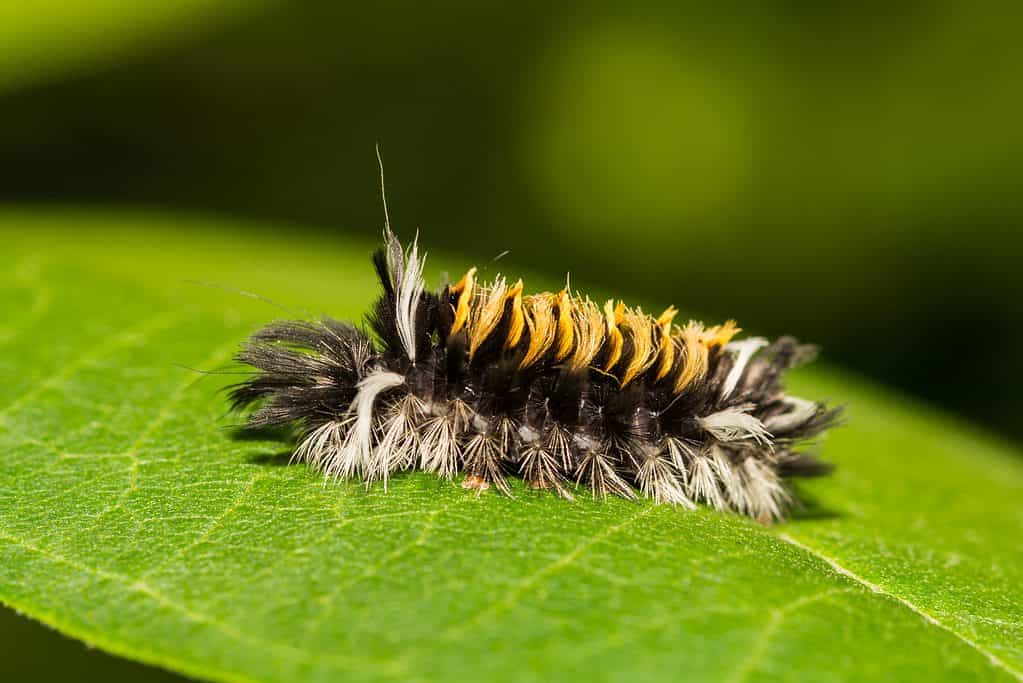
Milkweed tussock caterpillars look cute and fluffy, but you should avoid picking them up. Although they aren’t poisonous, the hairs are sharp and can cause irritation and rashes.
©Jay Ondreicka/Shutterstock.com
4. Banded Hairstreak
Also in Massachusetts is the banded hairstreak caterpillar. This lovely caterpillar has different color forms. They can either be creamy white with a green stripe and green blotches or green with a dark brown stripe and yellow lines. Another caterpillar form is light brown with or without lines and dashes.
Banded hairstreak butterflies are stunning. They have a wingspan of around 1 to 1.5 inches long. They are known for their light brown wings with a band of dark dashes with white edges. Banded hairstreak butterflies also have a distinct large blue tail spot.
These common butterflies are native to most of the eastern United States. These territorial butterflies are found east of the Rocky Mountains in North America. In Massachusetts, you can find banded hairstreak butterflies in semi-open areas, abandoned farms, gardens, and forest edges.

The banded hairstreak butterfly is mainly grey and brown. They have a wingspan of up to 1.5 inches long.
©LorraineHudgins/Shutterstock.com
5. Eastern Comma
The eastern comma is a butterfly in the Nymphalidae family. In the NatureServe conservation status system, this butterfly species is listed as secure. So, what do the caterpillars look like? Eastern comma caterpillars range in color but are generally spiny pale green to yellow. However, they are also sometimes green or white.
Eastern comma butterflies live throughout the eastern United States and small parts of southeastern Canada. These lovely butterflies have all-black or reddish-orange hindwings, depending on the season. These seasonal changes help the butterflies to camouflage with their surroundings and avoid predators. Regardless of the form, eastern comma butterflies have a silvery comma mark in the middle of the hindwing. They also have a wingspan of between 1.8 to 2.5 inches long. Eastern commas rely on camouflage to defend themselves. They are not toxic or poisonous.
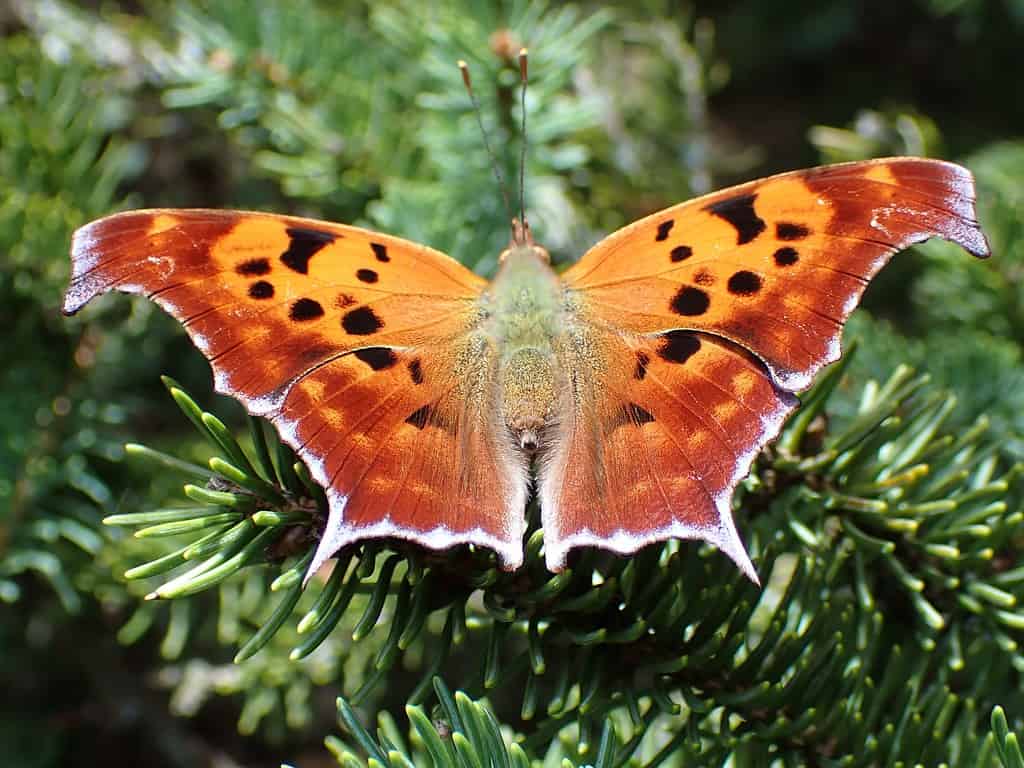
During summer and winter, eastern comma butterflies vary in appearance.
©Special Beauty/Shutterstock.com
6. Southern Flannel Moth
Have you ever had the pleasure of seeing a southern flannel moth? These fluffy moths are massive and go by many names. They are sometimes also called puss caterpillars, woolly slugs, and asp caterpillars. These caterpillars are thick and about an inch long. They have distinct long, luxuriant hair-like setae. While climbing on trees and trunks, they blend in impeccably. These hair-like spines are venomous and dangerous. Exposure to the spines on the skin can cause severe pain and skin irritation in the form of redness and marks. The reaction to this pain can include nausea, shaking, rashes, difficulty breathing, and blisters. According to the University of Florida’s Entomology and Nematology Department, puss caterpillars are one of the most venomous caterpillars in the United States. Technically, these caterpillars aren’t poisonous, but venomous as they can venom within their hollow spines.
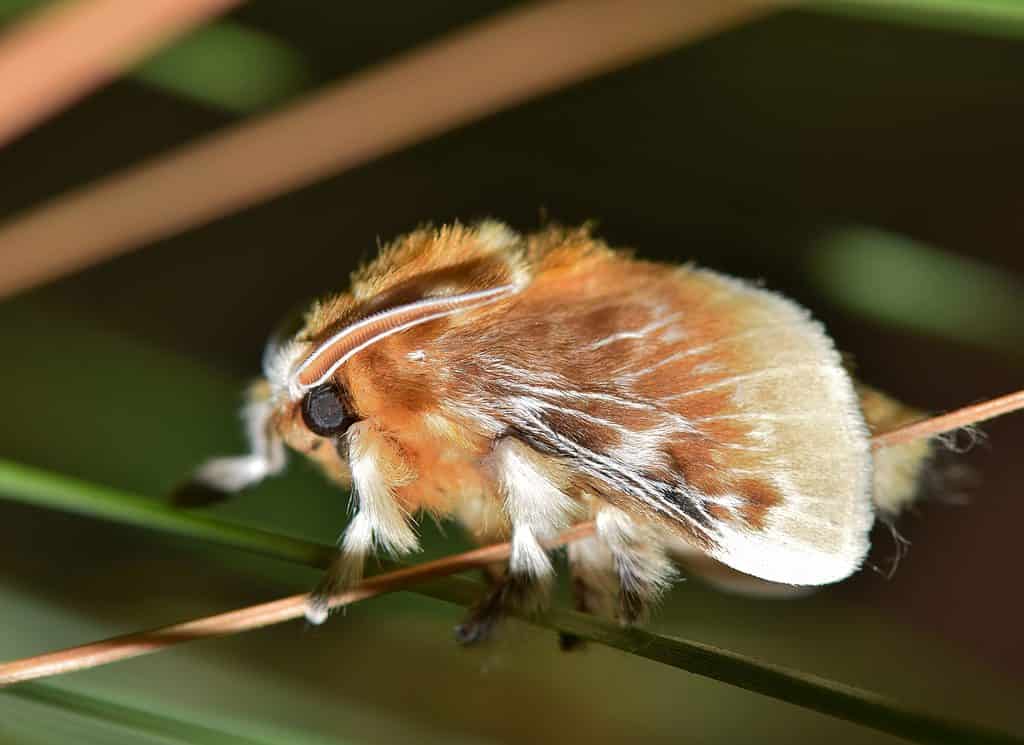
Southern flannel moths are furry moths. As young caterpillars, they are extremely venomous.
©Brett Hondow/Shutterstock.com
7. Forest Tent Caterpillar
The next caterpillar on our list is the forest tent caterpillar. The scientific name for this caterpillar is the Malacosoma disstria. These caterpillars turn into the forest tent moth. Despite their name, forest tent moths don’t build tents, but instead weave a silky sheet where they lie together during molting. These lovely caterpillars are vibrant and known for their unique markings and patterns. Generally, forest tent caterpillars are 2 to 2.5 inches long. They are also black, dark brown, or gray with a bright blue longitudinal stripe. Throughout the bright longitudinal stripe are also white spots. Along its sides are fur-like long setae.
Forest tent moths are native to North America. They are nocturnal and excellent at avoiding predators. As caterpillars, these lovely moths live in large groups. They forage together in groups of up to 200. While forest tent caterpillars are harmless, the hairs can cause irritation and allergic reactions.

Forest tent caterpillars are about 2 to 2.5 inches long. They have a unique pattern and live in large groups to avoid predators.
©jcohen9/Shutterstock.com
8. American Dagger Moth
The American dagger moth is also found throughout Massachusetts. You can find them in many residential areas, feeding at night in backyards. The scientific name for an American dagger is Acronicta americana. These lovely moths are typically harmless, although rather large. However, as caterpillars, they deliver powerful stings.
American dagger moth caterpillars are densely covered with pale yellow or white setae. These poisonous stinging caterpillars are especially dangerous to small children who accidentally touch their small hairs. The small hairs can break off and cause irritation that can develop into rashes and hives. Although these caterpillars mainly cause skin irritation, they are sometimes accidentally eaten by pets. American dagger moth caterpillars are extremely harmful to pets like dogs. If you suspect your pet has eaten an American dagger moth, call your local vet immediately for treatment.
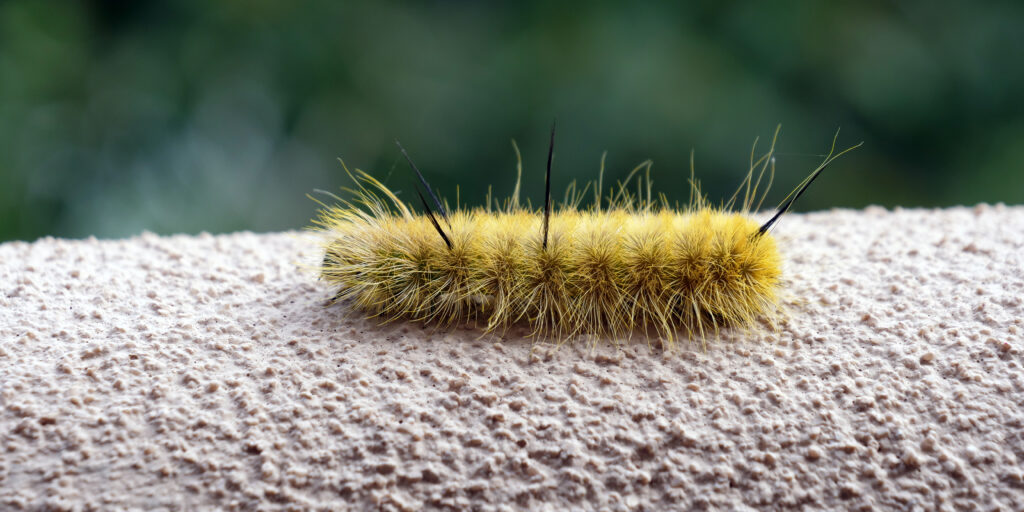
American Dagger Caterpillars are toxic and cause stinging when they’re touched. They are also poisonous to pets when accidentally consumed.
©Martha Marks/Shutterstock.com
9. Spicebush Swallowtail
Spicebush swallowtail caterpillars have a unique way of defending themselves from predators. These bright green caterpillars have unique markings. Before they turn bright green though, young caterpillars are brown and spend most of their days wrapped in leaves. Later forms of spicebush swallowtail caterpillars are bright green or yellow with black and yellow eye marks. Within the two eye marks are also two small curved white lines, that look a lot like eyebrows. This helps them stay safe from predators as it hides their identity. They may be confused for snakes instead of caterpillars.
Spicebush swallowtail caterpillars are harmless. They aren’t poisonous, which is why they rely on their mimicking talents to stay safe. They also release a foul odor when threatened. Spicebush swallowtails are native to the eastern US and southern Ontario. However, sometimes you can see these beautiful butterflies in the American Midwest, Cuba, Manitoba, and Colorado.
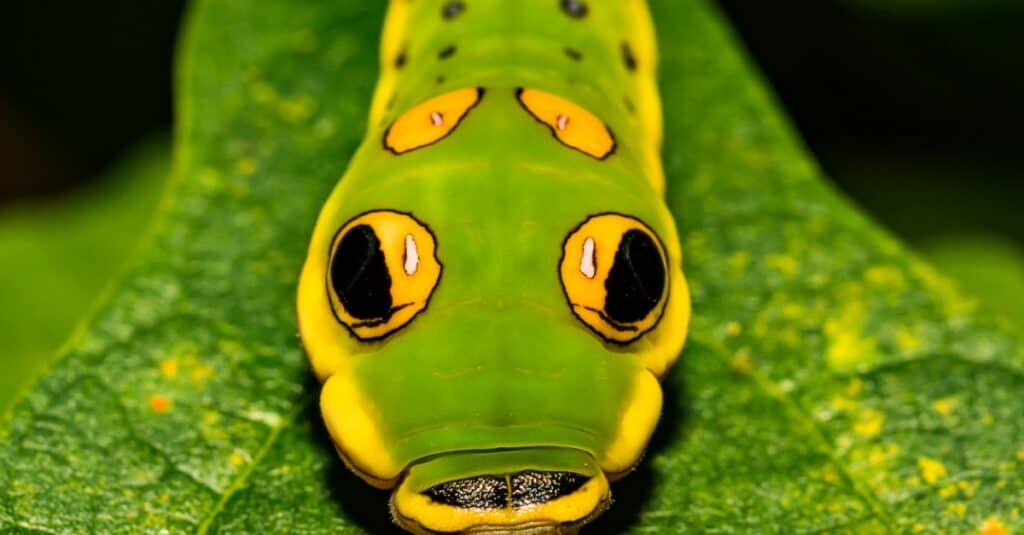
Spicebush swallowtails look like small snakes, which helps them avoid predators like caterpillars.
©iStock.com/JasonOndreicka
10. Tiger Swallowtail
The tiger swallowtail caterpillar is similar to the spicebush caterpillar. These caterpillars are typically brown for the first three instars. They are bright green with the fourth instar after molting and have a large white spot on the abdomen. On the thorax, you can also find two black, yellow, and blue eyespots. The eyespots are small but resemble the spicebush caterpillar’s appearance. Tiger swallowtail caterpillars are about 2.2 inches long. In Massachusetts, you can find these butterflies throughout the state in many gardens with plants like milkweed and buttonbush.
Tiger swallowtails feed on many different plants. You can find these lovely caterpillars on plants like aspens, birch trees, wild black cherries, and plants in the Lauraceae family.
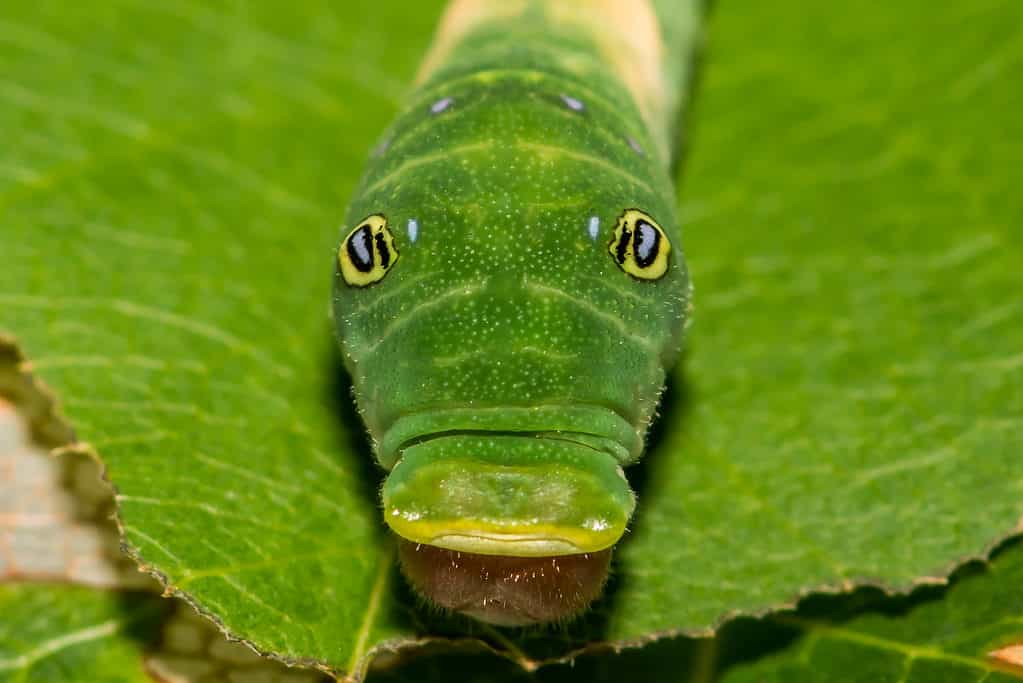
Tiger swallowtail caterpillars have small black, yellow, and blue eye marks/spots.
©Jay Ondreicka/Shutterstock.com
11. Yellow-dusted Cream Moth
Last but not least is the yellow-dusted cream moth. It’s not as common as the tiger swallowtail, but is still found in Massachusetts. They are sometimes mistaken for butterflies but have thicker bodies. Yellow-dusted cream moths have a wide range. You can find them from coastal northern British Columbia east to Newfoundland and parts of the United States. Verified sightings in the United States include Maine, Massachusetts, Minnesota, Wisconsin, Maryland, and Washington. This North American moth is a member of the Geometridae family. Yellow-dusted cream moths are small, with a wingspan of up to about 1.2 inches. They are nearly entirely white, yellow, and cream-colored.
The photo featured at the top of this post is © IrinaK/Shutterstock.com
Thank you for reading! Have some feedback for us? Contact the AZ Animals editorial team.







